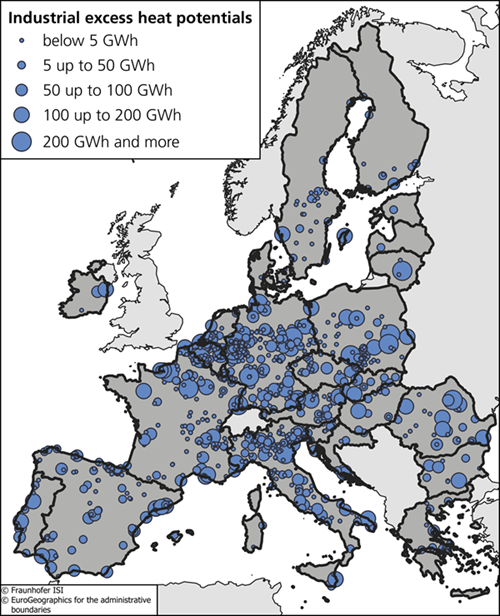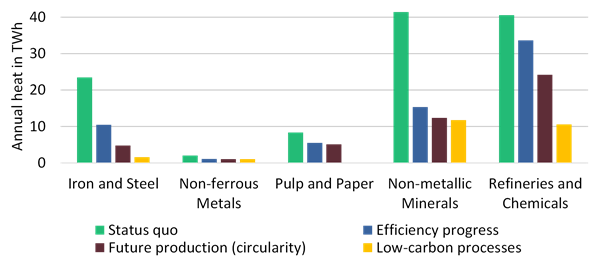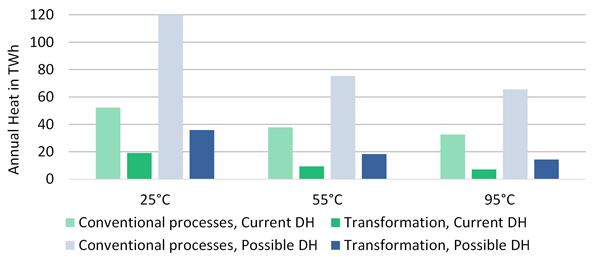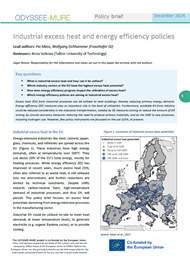Summary
Key questions
- What is industrial excess heat and how can it be utilized?
- Which industry sectors in the EU have the highest excess heat potential?
- How does energy efficiency progress impact the utilization of excess heat?
- Which energy efficiency policies are aiming at industrial excess heat?
Lead authors: Pia Manz, Wolfgang Eichhammer (Fraunhofer ISI)
Reviewers: Anna Volkova (Tallinn University of Technology)
Excess heat (EH) from industrial processes can be utilized to heat buildings, thereby reducing primary energy demand. Energy efficiency (EE) measures play an important role in the level of utilization. Furthermore, available EH from industry could be reduced considerably in the industrial transformation, notably by EE measures aiming to reduce the amount of EH arising, by circular economy measures reducing the need to produce primary materials, and by the shift to new processes, including hydrogen use. However, few policy instruments are focussed on the use of EH, at present.
Industrial excess heat in the EU
Energy-intensive industries like steel, cement, paper, glass, chemicals, and refineries are spread across the EU (Figure 1). These industries have high energy demands, often at temperatures over 500°C. They use about 20% of the EU’s total energy, mostly for heating processes. While energy efficiency (EE) has improved in recent years, much excess heat (EH), often also referred to as waste heat, is still released into the environment, and further reductions are limited by technical constraints. Despite shifts towards carbon-neutral fuels, high-temperature demand of industrial processes, and thus EH, will persist. This policy brief focuses on excess heat potentials stemming from energy-intensive processes in the manufacturing sector.
Industrial EH could be utilised on-site to meet heat demands at lower temperature levels, to generate electricity (e.g. organic Rankine cycles), or to provide cooling.
Figure 1: Locations of industrial excess heat potentials

Source: Manz et al., 2023
Another option is the utilisation of excess heat in district heating supply, thereby reducing its primary energy demand, and as one pillar in the transformation towards a climate-neutral energy system.
Industrial EH includes unused heat in exhaust gases, solid streams (e.g. hot coke, rolled steel, hot clinker), liquid streams (e.g. wastewater in paper production), cooling water, water vapor (e.g. from drying processes), and heat lost through radiation (e.g. furnace openings) or conduction (e.g. equipment surfaces). Available estimations of industrial EH mainly focus on the EH in exhaust gases from large energy-intensive sites due to limited data, representing the largest share of industrial EH. These studies identified potentials in the large range from 80 up to 800 TWh annually1.
Subsectors with energy-intensive processes
Industrial sectors, as well as refineries, have high specific EH potentials. Especially, processes like the production of steel, cement, and glass and refineries have high temperatures and, thus, often high EH potentials. In Table 1, we list the current estimated EH potentials.
Table 1: Excess heat potentials in industrial subsectors at a recovery temperature of 55°C
| Subsector | Available excess heat, annual, in TWh |
| Iron and steel | 23.4 |
| Non-ferrous metals | 2.0 |
| Pulp and paper | 8.4 |
| Non-metallic minerals | 41.4 |
| Refineries and Chemicals | 40.6 |
| Total | 115.8 |
Source: Manz et al., 2023
The highest EH potentials are from individual refinery and steel production sites. Sites from the non-metallic minerals sector produce glass or cement and have lower specific EH potentials. However, due to the larger number of these sites across the EU, this subsector has the highest total EH potential.
As stated above, the estimation of EH potentials is subject to data availability. The numbers listed here are at the lower end of the range of published literature values, including the high EH potentials from large-scale processes with high temperature needs, but missing smaller sites and production processes.
Impact of energy efficiency and industrial transformation
The current EH potentials from industrial sites are subject to change as industrial processes will become more efficient in the future. To achieve climate-neutrality in the industrial sector, all subsectors need to undergo a substantial transformation and the following steps are crucial: First, process heat will need to be supplied efficiently by renewable energy sources (i.e., electrification or hydrogen furnaces); second, process emissions stemming from chemical reactions (e.g. iron ore reduction using coal leads to CO2 emissions in steel production) should be avoided or reduced as much as possible; and third, material demand will change if material circularity is promoted. It is expected that many industrial processes will continue to produce EH, which cannot be used in the process or on-site for other purposes. However, this fundamental transformation will affect the EH available from industrial processes.
Figure 2: Impact of industrial transformation on annual industrial excess heat potentials

Source: Manz et al., 2023
Figure 2 shows an overview of the impact of different transformation steps on the available EH. The maximum level of internal heat recovery represents the implementation of BAT (best available technologies) exploiting the EE potentials of industrial processes. This can reduce the EH available for external uses by 40% on average by increasing the internal heat recovery. The reduced production of primary materials in the future due to the circular economy and the increase of secondary materials leads to a reduction of EH potentials, especially in steel production. Furthermore, the installation of electrified or hydrogen-fuelled furnaces replacing the currently often fossil-fuelled furnaces will reduce the EH potentials even further by an average of 20%. In summary, these effects could reduce the amount of EH in the future by 78–80% compared to current numbers. This underlines the need for EE policies that intrinsically reduce the generation of EH as mentioned above, through EE process improvement, circular economy approaches and the introduction of efficiently produced carbon-neutral fuels such as hydrogen.
Utilization of excess heat in district heating systems
Industrial heat can be utilized externally, especially for district heating (DH) to provide heat for space heating and hot water for residential and commercial buildings. A DH system needs to be close to an industrial site offering EH, and the demand for heat must be sufficient to utilize industrial EH.
DH systems themselves need be more efficient, moving to the so-called 4th and 5th generation DH with less heating loss, lower temperatures, climate-neutral energy sources, and flexible operation suitable for smart energy systems. The increase in efficiency of DH also impacts the amount of EH that could be one source of heat for DH. Furthermore, the expansion of DH areas in the future could increase the possibility to utilize EH, as more industrial sites are within an economic distance of DH areas.
Figure 3 shows the annual EH available for DH, for different temperature levels at which the heat is recovered, for the current and possible future status of the industry (“conventional processes” and “transformation”), for and the current and future expansion of district heating (“current DH” and “possible DH”).
Figure 3: Annual industrial excess heat potentials for district heating (DH)

Source: Manz et al., 2023
The possible utilization of DH decreases by 50% compared to the current potential and could supply 1% to 8% of the future DH demand. Reducing the system temperature in DH grids and expanding the DH supply areas could compensate for the decrease due to efficiency progress in industrial EH in the future.
When the temperature of available EH is lower than the supply temperature in the DH network, heat pumps can be used to increase the temperature.
Since the availability of EH varies throughout the day, thermal energy storage plays a crucial role in balancing the mismatch between EH supply and heat demand in district heating, thereby enhancing EH integration into the DH system.
EH from energy-intensive industries may only cover a small share of the DH supply. At the local level, how-ever, industrial sites are large point sources of EH and can provide a considerable share of the heat for DH.
Barriers for implementation
Several barriers can prevent the effective utilization of this resource and can be categorized as technical (e.g. temperature or profile mismatch, infrastructure limitations, necessary retrofitting), economic (e.g. high upfront costs, low economic benefits, and long payback periods), regulatory (e.g. lack of regulatory frameworks for grid access, ownership, and liability concerns for technical failures), and awareness-related barriers (e.g. missing technical expertise especially SME industries, unclear heat potential).
Addressing these barriers requires a combination of technological progress, financial incentives, regulatory reforms, and greater awareness of the benefits of utilizing industrial EH.
Policy framework
The Fit for 55 Package of the EU in July 2021 includes a revision of central legislation covering the transition towards a climate-neutral energy system. The increase of EE in industry and the utilization of inevitable industrial EH in efficient district heating and cooling systems are promoted in the recast of the Energy Efficiency Directive EED III (2023/1791). Article 25 requires Member States to conduct a comprehensive heating and cooling assessment, enabling the development of an efficient district heating and cooling infrastructure through a cost-benefit analysis considering the Energy Efficiency First Principle. It includes the preparation of heating and cooling plans in cities. Furthermore, policies supporting installations for the utilization of (industrial) EH should be developed. Article 26 defines efficient heating and cooling systems, with a high share of renewable energy and EH. Furthermore, new or refurbished industrial installations (energy input exceeding 8 MW) and data centres (energy input exceeding 1 MW) are required to utilize EH if technically and economically feasible.
Article 24 of the Renewable Energy Directive RED III (2023/2413) addresses district heating and cooling by strengthening the role of consumers and encouraging an increase in renewable energy sources in district heating and cooling. Another important aspect is the third-party access to DH networks.
In the recast of the Energy Performance of Buildings Directive EPBD (2024/1275), Article 11 includes efficient district heating and cooling, as defined above, as a possible source for zero-emission buildings, strengthening the role of DH possibly supplied with EH.
These EU directives are underway to be translated to the national policies of Member States. Many countries already have national policies promoting efficient heating/cooling and the utilization of industrial EH.
Table 2: Example national Energy Efficiency policy measures addressing heat potentials in the industrial subsectors

Source: MURE Database on Energy Efficiency Measures (www.odyssee-mure.eu)
The MURE database lists over 70 measures related to EH (key word “waste heat”), most of which are in industry (see Table 2 for examples). Waste heat from data centres is also increasingly a focus of policy measures, following the most recent recast of the EED from 2023.
One important example are the Danish Climate Agreement policies (see MURE database, cross-cutting measures) supporting and facilitating EH utilization, e.g. through tax exceptions and EH reporting. In Germany the Combined Heat and Power Act encourages the efficient use of industrial EH by providing incentives for combined heat and power systems. The Energy Audits require large companies to assess and report EH (requirement linked to the EED). In Finland, the Energy Efficiency Agreement includes guidelines for industries to report EH. Industries that sign up for the agreement are required to monitor and register their energy use, including EH recovery.
The existing national and EU policies already promote the increase of EE in industrial processes, the utilization of industrial EH in DH, and the expansion of DH, where cost-effective. However, the potential and location of industrial EH is still quite unclear, and the impact of the transition towards climate-neutrality makes it even more uncertain. This strengthens the need for EU-wide EH registration and reporting, to enable the adoption of policies addressing the full exploitation of EH, thereby reducing the primary energy demand for heating.
Notes
- 1: See: P. Manz, T. Fleiter, W. Eichhammer, The effect of low-carbon processes on industrial excess heat potentials for district heating in the EU: A GIS-based analysis, Smart Energy 10 (2023) 100103. DOI: 10.1016/j.segy.2023.100103.




